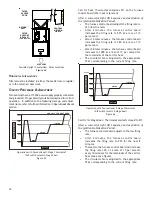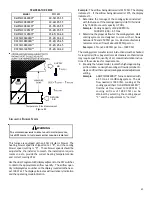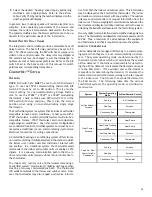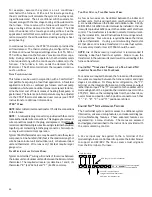
52
R
OLLOUT
L
IMIT
The rollout limit controls are mounted on the burner/manifold
assembly and monitor the burner flame. They are normally-
closed (electrically), manual-reset sensors. These limits guard
against burner flames not being properly drawn into the heat
exchanger.
P
RESSURE
S
WITCHES
The pressure switches are normally-open (closed during opera-
tion) negative air pressure-activated switches. They monitor
the airflow (combustion air and flue products) through the heat
exchanger via pressure taps located on the induced draft blower
and the coil front cover. These switches guard against insuffi-
cient airflow (combustion air and flue products) through the heat
exchanger and/or blocked condensate drain conditions.
F
LAME
S
ENSOR
The flame sensor is a probe mounted to the burner/manifold
assembly which uses the principle of flame rectification to
determine the presence or absence of flame.
T
ROUBLESHOOTING
E
LECTROSTATIC
D
ISCHARGE
(ESD) P
RECAUTIONS
NOTE:
Discharge body’s static electricity before touching unit.
An electrostatic discharge can adversely affect electrical
components.
Use the following precautions during furnace installation and
servicing to protect the integrated control module from dam-
age. By putting the furnace, the control, and the person at
the same electrostatic potential, these steps will help avoid
exposing the integrated control module to electrostatic dis-
charge. This procedure is applicable to both installed and
uninstalled (ungrounded) furnaces.
1. Disconnect all power to the furnace. Do not touch the
integrated control module or any wire connected to
the control prior to discharging your body’s electrostatic
charge to ground.
2. Firmly touch a clean, unpainted, metal surface of the
furnace away from the control. Any tools held in a
person’s hand during grounding will be discharged.
3. Service integrated control module or connecting wiring
following the discharge process in step 2. Use caution
not to recharge your body with static electricity; (i.e.,
do not move or shuffle your feet, do not touch
ungrounded objects, etc.). If you come in contact with
an ungrounded object, repeat step 2 before touching
control or wires.
4. Discharge your body to ground before removing a new
control from its container. Follow steps 1 through 3 if
installing the control on a furnace. Return any old or
new controls to their containers before touching any
ungrounded object.
D
IAGNOSTIC
C
HART
HIGH VOLTAGE !
T
O
AVOID
PERSONAL
INJURY
OR
DEATH
DUE
TO
ELECTRICAL
SHOCK
,
DISCONNECT
ELECTRICAL
POWER
BEFORE
PERFORMING
ANY
SERVICE
OR
MAINTENANCE
.
WARNING
Refer to the
Troubleshooting Codes
for assistance in deter-
mining the source of unit operational problems. The dual 7-
segment LED display will display an error code that may con-
tain a letter and number. The error code may be used to assist
in troubleshooting the unit.
R
ESETTING
F
ROM
L
OCKOUT
Furnace lockout results when a furnace is unable to achieve
ignition after three attempts during a single call for heat. It
is characterized by a non-functioning furnace and a
E 0
code
displayed on the dual 7-segment display. If the furnace is in
“lockout”, it will (or can be) reset in any of the following
ways.
1. Automatic reset. The integrated control module will
automatically reset itself and attempt to resume normal
operations following a one hour lockout period.
2. Manual power interruption. Interrupt 115 volt power
to the furnace.
3. Manual thermostat cycle. Lower the thermostat so
that there is no longer a call for heat for 1 -20 seconds
then reset to previous setting.
NOTE:
If the condition which originally caused the lockout
still exists, the control will return to lockout. Refer to the
Troubleshooting Codes
for aid in determining the cause.
Содержание DC97MC
Страница 63: ...63 THIS PAGE LEFT INTENTIONALLY BLANK...











































